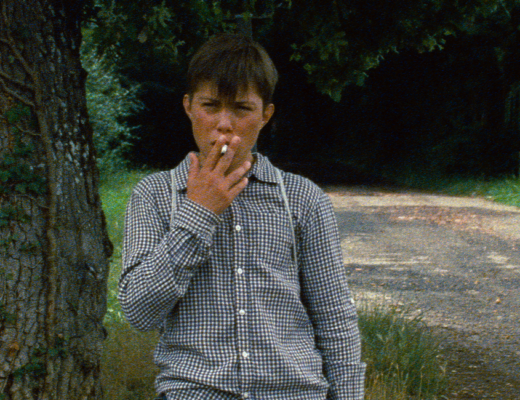Film often exists in a curious relation to the art world. Though there’s no formal distinction between film and video art or artists’ moving image, the movie theater and the gallery remain largely disparate spaces. Though artist Wendelien Van Oldenborgh has more frequently worked in the latter space, her new single-channel film installation (as her website describes it), of girls, is her latest to premiere at FIDMarseille. Given its status as a home for some of the more innovative directors in the film world, it makes sense that FIDMarseille would also bridge this gap. Van Oldenborgh’s film is still likely to stand out: at 43 minutes, it’s the shortest work in this year’s International Competition, and its directorial approach feels particularly academic. It’s not, however, an entirely inappropriate context, the film not altogether too inaccessible.
In of girls, a diverse group of artists, writers, and academics read and discuss the work of Fumiko Hayasashi and Yuriko Miyamoto, two feminist 20th-century authors from Japan. Though literature is at the center of the film, a variety of disciplines are engaged; likewise, though only Miyamoto was explicitly queer, both writers’ works are read through the lens of modern queer theory. Each has an important political legacy, as Miyamoto was often censored and imprisoned for her communist writing and activism, and Hayasashi participated in producing state propaganda in Japan’s occupied territories during World War II. The preservation of Hayasashi’s house as a museum also allows Van Oldenborgh to continue her work’s exploration of architecture. All this is a bit overwhelming in the absence of prior knowledge of the two writers, and complicated by the fact that translation is both an additional subject of the film and almost a necessity to engaging with it, as its dialogue comprises both English and Japanese.
Fortunately, the film’s speakers approach these subjects with humility, preventing their discussions from becoming impenetrable. The same passage is sometimes read in both languages, and the differences are a challenge to discern when the Japanese is translated back into English subtitles, but the ambiguity inherent to translation becomes almost a text in itself as the speakers disentangle the effects of the translation. Similarly, when discussing the eroticism of Hayasashi’s writing about women, a queer theorist admits to lacking the historical context to know if this would’ve been unusual. Introducing some uncertainty into the academic rigor of the discussions presents an entry point for a wider audience.
Van Oldenborgh’s primary visual conceit parallels the doubling of subjects and languages. The film is presented not quite in traditional split-screen, but with one image on the left fading into another on the right. Often, though not always, the two shots are of the same performers in the same location. The effect is unusual enough to provide consistent visual interest, which is welcome but occasionally distracting given the necessity of reading subtitles. Sometimes the shots blend into each other seamlessly until an actor in one also walks into the other. At one point, Van Oldenborgh seems to become particularly interested in one performers’ striped shirt, placing her in the center of both shots so that the pattern overlaps. The two shots also allow Van Oldenborgh to transition back and forth between discourses, and again, the subtitling is foregrounded as overlapping speech becomes inherently less accessible than overlapping images.
Combining formal concerns more consistent with experimental film is going to be a challenge for audiences. Given this, it seems that perhaps the medium-length feature is a natural format for such a work; the multidisciplinary engagement would likely fill a short film to bursting, and though it could likely sustain a longer runtime, Van Oldenborgh’s film as constituted offers a more manageable compromise between accessibility and discursive specificity. of girls is a worthy reach from the art world into that of the film festival, and although it also stretches the rhetorical limits of film criticism, or at least this film critic’s, Van Oldenborgh offers ample support to meet her single-channel film installation at its level.
Published as part of InRO Weekly — Volume 1, Issue 28.







